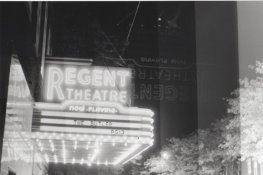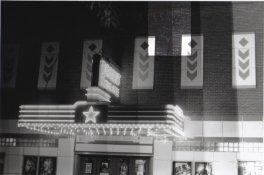But, if the film is so reflective and there is something (filter, back of mirror, etc.,) reflecting the film reflection back to the film inverted, why wouldn't this be obvious in daylight exposures as well? The path of incoming light rays would remain the same both at night and during the day. The absolute intensity would be greater during the day so I would expect the effect to be intensified then, but that does not seem to be the case. Also, If one of these explanations did fit, why is the inverted image sharp and the same size as the normal exposure? I would think all those reflections would be causing the light to travel a different focal length and thus be out-of-focus.
The day vs night comparison really complicates any explanation.
Some other thoughts: the light rays coming into the camera are refracted and travel a path the either ends up with a focal point on the groundglass screen, or when the mirror is out of the way, on the film. Those paths have identical focal lengths. The image coming through the pentaprism is not being focused at the same focal length as the lens. Every part of the screen image is at the same plane and the diopter in the viewfinder has a separate focal length that brings that planar screen image into focus. And if the viewfinder groundglass image was being reflected, refracted, or transmitted, the mirror would have to be in the down position and the shutter closed. If the mirror was up, there wouldn't be any image reflected to the screen as all the light would be traveling through the camera directly to the film.

The image on the focusing screen is reversed laterally when viewing without a pentaprism to correct it but it appears upright (ala TLR as above) while the image at the film plane will be inverted and laterally reversed on the emulsion surface (ala view camera groundglass image or taking lens of a TLR). But, the focal-plane shutter is closed when the mirror of a 35mm slr is in the light path so the film couldn't receive an image at that time. The mirror must be out of the way to image at the film plane. But if the mirror is out of the way, there is no image on the groundglass screen of the viewfinder, and nothing is reversing the image coming from the lens that would put it upside down at the film plane at that focal distance. And even if something were below that screen, any image from it would have to be reflecting from something facing the opposite direction of the mirror when down for normal viewing. If there was a reflective something at 90 degrees to that resting mirror orientation and the shutter was open, the reflection would be inverted and laterally reversed at the emulsion. But there is nothing there in that position and angle when the shutter curtain is open (or closed for that matter). But if there was, the secondary image on the emulsion could be recorded as it appears on the now-developed film.
My brain hurts...














